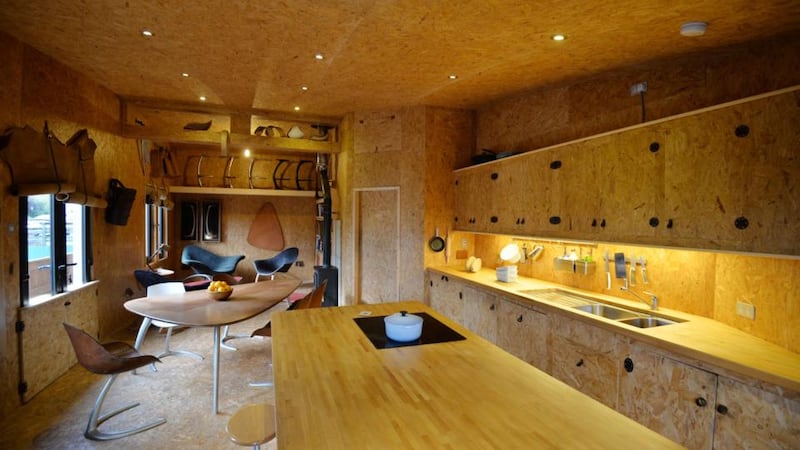Garvan de Bruir is a designer who sells manbags and technology cases from a man cave in Co Kildare. While architecture was his first love, he studied cabinetmaking and for his graduate show presented hyper masculine modern furniture using his favourite material, leather.
The recession put paid to any hope of getting commissions for such works so he downsized, excelling at easier-to-sell leather luggage and accessories.
He lives and works in Co Kildare in the grounds of the family home, where his cave-shaped workrooms surround a courtyard which is home to one of his playful swings.


In the studios there is heavy duty machinery and saddler sewing machines to make his leather goods but it is another local industry, the army, in which his father served, that inspired his love of hides.
Ammunition cases, salvaged from a local barracks that was closing down, are used as storage boxes. “They’re perfect in a workshop environment,” deBruir says.
However, it’s the structured yet decorative elements of the army uniform that appeal to de Bruir: the Sam Browne belt, the holster and the high class polish. He also likes the fact that the better you treat it, the better it looks.
His home is a spacious studio, a wooden construction on stilts made of salvaged telegraph poles, positioned over a steep embankment that had been considered a dead space.
From the outside the cave looks more like a treehouse. Inside the walls are constructed from Irish-made oriented strand board (OSB), considered a packing material. It is similar to plywood and usually covered but de Bruir likes the texture, warmth and decorative element it offers.
It’s not everyone’s cup of tea, he admits, but it is visually different to being in a white room. “Visually it feels warmer. It’s light inside even when it’s dark outside.”
The space is about 55 square metres in size and has a curved, cave-shaped roof that allows the rainwater to run off, a subtle point of design difference that runs through all his work.
The standard Ikea kitchen carcasses have been loaded up with de Bruir testerostone. Fronted in OSB they have leather hinges and door pulls. There's a wine rack made from a strip of leather. Single-form aluminium stools that resemble the cartoon character Road Runner are positioned animatedly around the rectangular island. Hides replace regular curtains with equestrian-style leather straps used to draw them up. The place is a vegan's worst nightmare.

It’s all one big experiment, de Bruir says. “It’s about finding solutions. The leather trays on the shelves in the office area came out of needing something to put tools into that wouldn’t mark the leather while we were working on it in the studio.” The boxes cohabit with to-scale models of some of his work including a single-form swing that he’s sold to a client in Denver.
There is a large dining area, where a graduate piece, an amoeba-shaped leather-covered table and leather bucket chairs on aluminium cantilevered horseshoe pedestals can accommodate up to six or seven people. The table is marked and aged but de Bruir likes that and constantly tests the material’s ability to take abuse by putting hot cups and pots directly onto the surface.
To the rear there is a sitting area where several rocking chair prototypes, two covered in sheepskin and a more refined version in leather, are positioned around a smaller coffee table version of the dining table, also covered in leather. Prototypes of other designs fill the shelves.
The engines of the house – the bathroom and wardrobe – are hidden from view behind a door. Steps lead up to the bathroom, the only part of the house with which he’s disappointed with. He had wanted to build it as a fibreglass pod but opted to tile the room instead. While functional it lacks his strong signature aesthetic.
The house is a cocoon, de Bruir says. “The space is to teach me more about leather and design. Thanks to the salvage element it cost about €20,000 to build but there were fixed costs to the bathroom and kitchen.”
The house is devoid of any frippery. This is a feminine and floral-free zone. Ornamentation is a crime, deBruir says. “If it doesn’t do something then I don’t need it. My brief is based in functionality. I am ruthlessly efficient in what the functional requirements should be and object if well designed and made it should last a lifetime.”
But where does he sleep? The bed “snoozes” under the TV when it’s not in use. When it’s time to turn in, deBruir uses a pulley to lift a wooden flap that reveals the bed, a roll-out design that slides out from under the bathroom.
Garvan de Bruir's workshops open Monday to Friday 9am-5 pm or you can ring in advance on weekends. debruir.com








